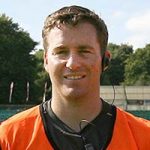Improving your killer instinct

We have all seen the athlete who appears to have it all:
- the natural talent
- the physique
- the technique
- the training programme
but when it comes to producing the goods on the big day, they seem to fall short. Often it can be difficult to put your finger on where they are going wrong, but in many cases it simply comes down to a lack of desire, or what is known in sport as the killer instinct.
An athlete can appear to be the complete package, but if they don’t have the hunger to give that last ounce of effort to do anything to see off their rivals, then it generally counts for nothing. To see an athlete almost settle for second best or just cruise along at 90 per cent, is something that is most frustrating for fans and coaches. The difficulty has been that while there are training methods that will improve areas such as speed, endurance or strength, it has seemed almost impossible to instill a hunger in an athlete. It is often something that is manifested in an athlete who has been particularly strong at youth level. They don’t have to have a killer instinct to see off their rivals as talent alone is sufficient. The problem is that when they step up to elite level in the adult ranks they are faced with opponents of similar talent, and they haven’t developed that hunger or killer instinct needed to overcome the new challenges facing them.
Desire is a positive trait
This is an area that has been addressed in an article by Wayne Goldsmith who suggests that steps can be taken to improve this desire. A killer instinct is undoubtedly something that is part of our genetic make-up and is linked to the idea of the survival of the fittest that has allowed man to survive and develop over the years. It has been described in many ways, including ‘an aggressive tenacious urge for domination in a struggle to attain a set goal ’. Goldsmith acknowledges that the term gives rise to some negative connotations but stresses that it does not mean that an athlete is going out to cause any damage to opponents or mean that they have some primal tendencies. He points out that it is in fact a very positive trait and, in many cases, essential trait for a successful athlete, as he states:
Put simply, a Killer Instinct is an inner drive – a passion – a motivating force that inspires people to realise their full potential. It’s an energizing and uplifting personal philosophy of “I can do better AND I will give everything I’ve got to achieve it”
Tips for improving your Killer Instinct
Goldsmith accepts that in many cases sport is about participation and fun, but points out that in terms of competitive sport, winning is the main focus and this is where the killer instinct can make all the difference.
Does it mean that if athletes don’t win then they’re “losers”? Of course not. But what it does mean is that athletes, coaches and sporting parents need to accept the reality of competitive sport: you win or you lose – but you don’t have to like it and more importantly – you have it within you to do something about it
he points out as he puts forward his suggestions for ways of developing a killer instinct as follows:-
- Titles not times: Forget records. Forget personal bests. Forget tracking your percentage improvements. Compete to win.
- Race to win: Feel free to think about, talk about and train hard for winning. Get comfortable talking about winning. It’s not a rude word. It’s what you crave.
- Focus: Stop chasing a fraction of a second here so you can qualify for this event or that competition. Focus instead on the development of the full complement of competitive skills – (physical, mental, technical, tactical and strategic) that you need to win and embrace a relentless commitment to excellence and hard work in practice and guess what….the qualifying will take care of itself.
- Win in practice: Training is not just training – it’s winning practice. Just doing the laps will not make you a winner.
- Develop Playing skills – not just Staying skills: Players – winners – focus on also developing the complete range of performance skills they need to meet the demands of every situation they face in competition.
He goes on to argue that coaches can also help develop the killer instinct in their athletes by coaching them to be great competitors, not just great trainers. This can be achieved by creating competition in training, and learning from losing. He also suggests that it is important to keep parents involved and to be a tough coach when required. He also suggests that it is important to keep parents involved and to be a tough coach when required. The ideas are backed up by Jason Stanley in The Killer Instinct, who points out:
People who have the killer instinct contest the impossible. People who have the killer instinct never quit. They believe that their goal (whatever it might be) is first priority, and everything else takes a back seat
He suggests that this outlook can be developed through a two-way process. Firstly you’ll need to attach your strongest emotions to your goal. You need to attach them to achieving, winning, and being the best you can be. Those emotions or how you feel is what drives you to take action. The stronger the emotion, the greater the action. Secondly you need to think about the result if you achieved your goal. How would you feel? Try to physically feel the feeling of achievement and success as if you already have it.
Know how to win
Dr John Murray sums up what is required when he argues in Developing the Killer Instinct that being close to an easy victory is one of the most vulnerable positions in sport and that the killer instinct must kick in to see the game through.
It is important to know how to win. The mental skills needed to close out a match need to be understood, practiced and refined over and over. With these skills firmly in place, the player will have developed the killer instinct
What is Metrifit?
Through our innovative app and intelligent analytics, we are bringing athlete well-being to the forefront of training and performance. While we acknowledge the physiological aspects of training and provide tools to monitor those aspects, we also build a subjective and objective profile of the athlete that allows coaches to track the physical and mental well-being of their athletes helping them to reach optimum performance.
To find out more visit our Metrifit Product Overview page or contact at for a free demo.
Please share this post so others may benefit.
Follow @metrifit

References
5 Pratical ways to develop a killer instinct by Wayne Goldsmith
Chase Down or Bust by Sam Taylor
Developing the Killer Instinct by Dr. John Murray
































 Previous Post
Previous Post Next Post
Next Post





